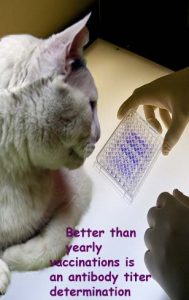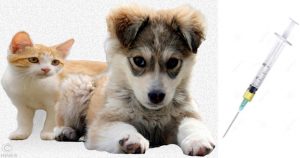Ron Hines DVM PhD
 See What Normal Blood & Urine Values Are
See What Normal Blood & Urine Values Are
 Causes Of Most Abnormal Blood & Urine Tests
Causes Of Most Abnormal Blood & Urine Tests
Antibody Titer
Your pet’s blood antibody titer (level) against specific virus diseases can be measured in many ways. The most accurate and informative way is with a virus neutralization test (aka VN test aka plaque reduction test). Your pet’s virus neutralization titer tells us considerably more than running the more common titer tests that are simpler but less informative, tests such as HA, HI tests, IFA or ELISA. When a living virus, added to your pet’s blood sample is found to be destroyed (“sterile immunity”), we know for sure that your dog or cat is well protected. But even when the virus is not destroyed, it is important to remember that immunity can last for long periods (years or a lifetime) even after antibodies can no longer be detected in your cat or dog’s blood. That is because of a process called immunological memory. Certain immune system cells persist in the body for very long periods. They do not destroy virus or bacteria. But they contain the instructions that other immune system cells use to rapidly produce the correct antibody to quickly overcome a second infection. Certain virus have found ways to defeat that protection. They are the virus that mutate frequently, producing strains that are no longer susceptible to the original antibody blueprints. One example is canine influenza. So interpreting your dog or cat’s antibody protection is considerably more difficult than interpreting many of the other laboratory tests I discuss on other webpages. There is rarely anything black or white when it comes to you or your pet’s immunity.
Antibodies (immunoglobulins) are special, tailor-made proteins that your cat or dog’s immune system designs by trial and error to kill invading disease organisms. They find vulnerable spots or essential process in the virus and disable them causing the virus’ death. Other antibodies have the ability to recognize and “tag” virus and other invaders so that other cells of your pet’s immune system can later find and destroy them. Antibodies are located in the globulin (GLB) portion of your pet’s blood where they, along with albumin, make up the sizable portion of your pet’s total blood protein (TP). Antibodies are produced by your pet’s plasma cells, a type of lymphocyte. Without antibodies, neither us nor our pets could survive for long. Animal and human bodies can produce an amazing number of unique antibodies (about 10x 8th different ones = one hundred million). If they all remained in circulation at the same time, blood would be too thick to flow. Immunological memory solved that issue. When no longer needed, only the instruction books to rapidly produce them (immunological memory) remain.
It is such a complicated process that antibodies are also occasionally produced in error; in which case they can be responsible for autoimmune disease and allergies. Antibodies are, on rarer occasion, promiscuous, with the ability to affect more than one target. Such is the case with leptospirosis vaccines. Sometimes it appears that it is the antigen itself that is promiscuous, as in the Alpha-gaL syndrome.
How Is Antibody Titer Reported?
Your pet’s antibody titer to a virus, bacteria or other foreign protein represents the current circulating amount of one of those unique antibodies that I mentioned that is still in its system. It is calculated based on the amount that a serum sample from your dog or cat can be diluted (serial dilution) and still see evidence that the antibody is present. If antibody can still be detected when your pet’s blood is diluted 1 part serum plus 7 parts diluent, its titer is 1:8 (one in eight). When that 1/8 dilution is itself diluted in an equal amount of fresh diluent and is stills positive for antibody, your pet’s titer is 1:16. That has traditionally been carried on for ten dilutions which would represent titers of 1/8, 1/16, 1/32, 1/64, 1/128, 1/256, 1/512, 1/1024, and 1/2048. The bigger the second number, the more antibody was present in the original sample and, hopefully, the more immune your pet is to a specific pathogen. Some current antibody tests report in values other than the 1:8-1:2048 scale.
Positive titers (other than colostral titers in nursing puppies and kittens) indicate prior exposure or vaccination. A significant rise in titer over time – when it did not relate to a vaccination – is very good evidence that your pet has a current infection. But low titers or no titers can be considerably more difficult for your veterinarian to interpret.
Antibody versus invading disease organisms is a battle that can tilt one way or the other based on the relative number of both the invader and the antibody, as well as your pet’s general health. It is thought that large numbers of invading organisms (a high challenge dose) can overwhelm antibody levels in dogs or cats that are protected against smaller doses of disease-causing organisms. In some situations, corticosteroid medications or chemotherapy drugs have the ability to lessen the effectiveness of antibody protection.
At its simplest, a high antibody titer in your pet shows that the pet was exposed to the disease organism or a vaccine composed of that organism. It does not directly tell you that any ill health your pet is currently experiencing is due to that organism. For example, in areas where Lyme disease is present, most dogs have antibody against it. So finding antibody may have nothing to do with your dog or cat’s current health problems. For parvovirus of dogs and canine distemper, anything = 1:50 – 1:80 titer is generally considered protective. For canine adenovirus-1, = 1:50, for rabies = 1:5 is thought to be protective, for panleukopenia of cats = 1:10 is thought to be protective.
For leptospirosis, >1:100 titer is thought to be protective. Many believe that leptospirosis titers of equal or exceeding =1:400 are associated with current infection. Others use 1:800 as the cut-off. Yet, some infected dogs never exceed 1:100. What is more suggestive of your dog having a current leptospirosis infection or recovering from one is documenting a rising titer over a period of a week or two.
Herpesvirus (rhinotracheitis aka cat flu) titer determinations in cats are of little value to your veterinarian since these titers are quite erratic.
Some titer levels, such as calicivirus titer in cats, that are reported back from a laboratory as “protective” do not prevent reinfection. But they probably prevent infection in your cat from developing into overt disease (=non-sterile immunity). To complicate matters, some cats with no residual titer to calicivirus still seem to be protected.
When Should I Request That My Dog Or Cat Have An Antibody Titer Test?
There are several situations when determining your dog or cat’s antibody titer levels might be desirable:
1) As an alternative to frequent vaccinations – no need for booster vaccinations if your pet is still protected. There are considerable downsides to over-vaccination. (read here)
2) To identify an ongoing disease or rule one out. However, early in bacterial or viral diseases, antibodies against them are often absent or low enough to just represent “background noise”. For diagnosis, several titer tests showing a rise in your pet’s titer is considerably more accurate.
1) A few weeks after your puppy or kitten’s last initial vaccination series to confirm that it is truly protected. That is particularly true if the likelihood of exposure will be high or if you lost a prior pet to an infectious disease and need reassurance that that is not likely to occur again.
4) To detect antibodies produced in error – the cause of autoimmune disease. However, in my opinion, currently marketed blood allergy tests, based on your dog or cat’s antibody levels to common allergens are valueless.
What Does A High Antibody Titer In My Pet Mean?
It means your cat or dog was exposed to an invading organism, produced protective levels of antibody against it and overcame the infection. It can also mean that your pet was successfully vaccinated against the organism. With time, antibody levels often decrease; so a very high titer can also mean that the infection occurred recently. Antibody levels in your newborn pet came from their mother’s first milk (colostrum). They decrease over the first 9-16 weeks of its life. In the case of rogue antibodies directed against your dog or cat’s own tissues, it usually means autoimmune diseases.
What Does A Low Antibody Titer In My Pet Mean?
It can mean that your pet was never exposed to a specific infectious disease. It can also mean that a vaccine that was given did not protect your pet sufficiently. That commonly occurs when vaccines are given at too young an age. You are always safer to isolate your puppy or kitten from all sources of infection and wait until its immune system is fully developed before vaccinations are given. When that cannot be assured, a series of vaccines need to be given with the final, most important, one given between 16-18 weeks of age. It can mean that your pet has the disease but has not had time to produce antibody yet. Some medications can lower certain antibody levels (anti-tumor drugs, immunosuppressive drugs like cyclosporine and corticosteroids). (read here, & here)
Does A Low Antibody Titer To A Disease Mean That My Pet Is Not Immune To It?
Not necessarily.
I mentioned that low titers and no titers can be considerably more difficult for your veterinarian (or your physician) to interpret. That is because of two things: When it comes to vaccine protection, there are no firm cut-off titer values at which veterinarians know for sure that pets are protected or not protected. It is always best to have the laboratory that ran the antibody test give you their opinion on what constitutes protection or current infection. But remember that even these biomedical laboratories are simply making an educated guess. Since so much is still unknown, the laboratories generally err on the side of caution. Because different laboratories use different methods and interpret their data in different ways, the results from one facility cannot be applied to previous results from another facility. The second factor that makes low or no titer results hard to interpret are two phenomena. One is immune memory that I already mentioned. The other is mucosal immunity. Neither are measured by standard blood antibody titer tests. Mucosal immunity is a barrier to infection that prevents invading organisms from gaining access into your pet (read here).
Complementary Tests:
When your pet is already ill, PCR tests for evidence of the pathogens themselves are highly accurate
DxMe
You are on the Vetspace animal health website
Visiting the products that you see displayed on this website help pay the cost of keeping these articles on the Internet.



